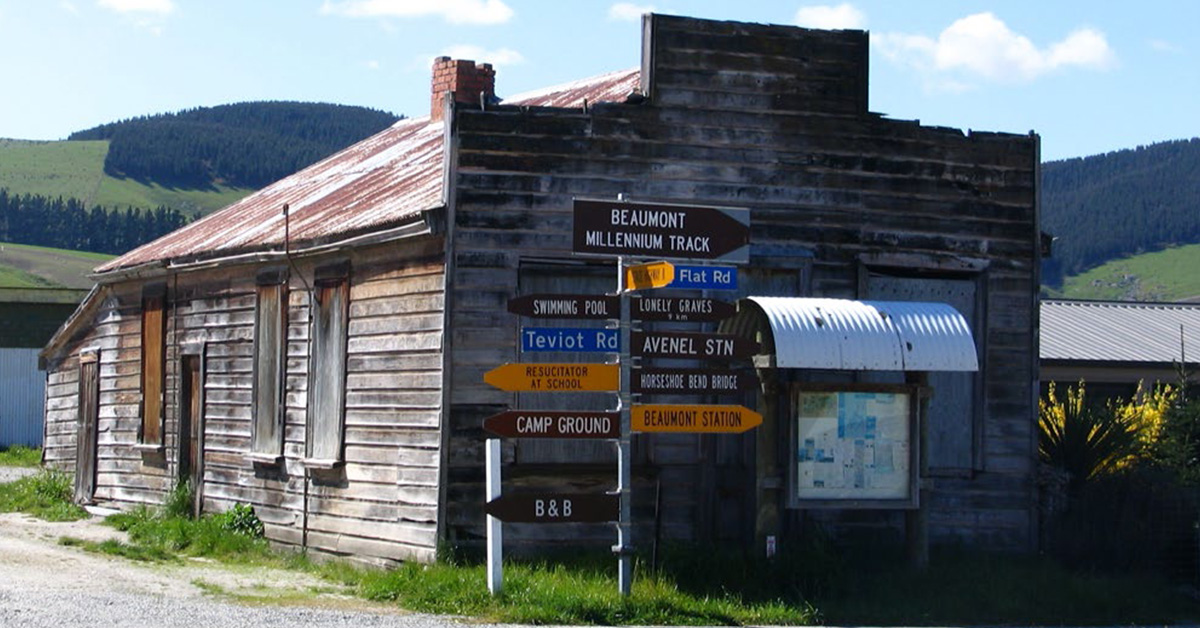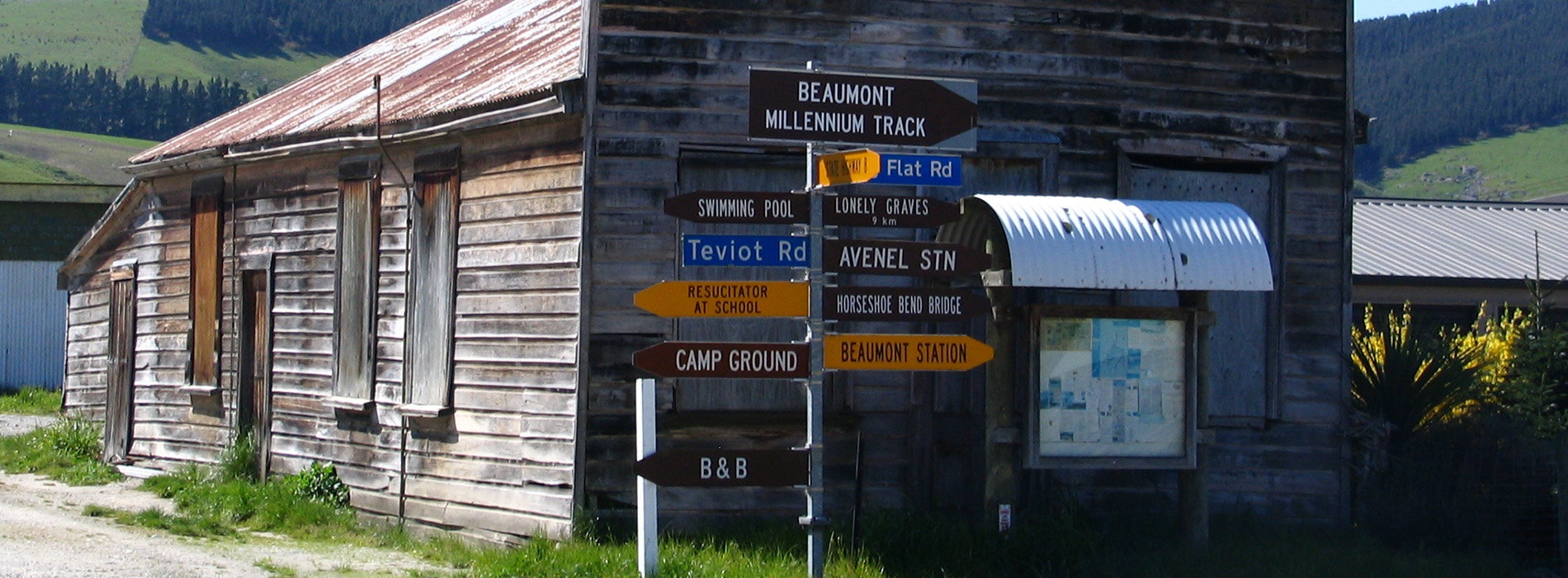
Culture Etc.

Above: By the Millers Flat bridge, Otago. Photo: Benchill, Creative Commons.
About Town: Millers Flat
The sun-bleached landscapes of a Central Otago summer evoke childhood memories of stonefruit, freedom and family.
By Nicholas Sheppard
From the summit of the hill behind my grandparents’ property — a day’s hike for a child — the winding Clutha River looks as pristinely still as a photograph, chilly and fresh amid the midday swelter. It’s a view so beautiful that it remains indelible in my mind’s eye after most else has faded into abstraction.
My grandparents lived in Millers Flat, along the stretch of Highway 8 which takes you from Roxburgh to Cromwell. Spanning the heart of the scenic Teviot Valley and the shores of the Clutha River, it’s an area layered with history stretching back to the gold rush of the 1860s, when the provisional towns of Cromwell, Clyde and Alexandra were first slung together from calico, sod, stone, mud‑brick and tin.
The thousands of prospectors who flooded in found the Otago hinterland wilder and more rugged than anywhere they’d been before. The winters blistering cold, the summers scorching hot, it was a region of desolate mountain ranges, grey trees bent sinuously to the wind, and unforgiving rivers. Remnants of the gold miners’ dwellings, formed from schist chiselled out of the hills, lie strewn throughout the area. From time to time, parts of the Clutha recede to reveal submerged huts.
The wider area also has Edwardian traces — a graveyard near Roxburgh with its moss and lichened headstones, cracked marble, and rusted and warped iron curlicues is the resting place of Protestant folk as roughly hewn and abiding as the landscape itself. Layered on this are remnants from the 1950s, when retirees like my grandparents settled in the area: postwar clapboard-and-brick houses, some rooms still with their William Morris wallpaper 30-odd years later. They had sun rooms full of cane and wicker settees — mostly drab or functional furniture, but there was the occasional surprising heirloom piece: a carriage clock or charming escritoire with little stops and volutes and even hidden compartments on tiny spring latches. On the wall, there might be one of those supremely kitsch mass-reproduced paintings of a reclining Polynesian girl (the kind that modern hipsters find ironically cool) with her skin painted hues of blue or green. Alongside it might be a Peter McIntyre painting now worth thousands.
On side tables were loose stacks and jumbles of sporting almanacs, Footrot Flats, seasonal planting brochures with pastel illustrations of daffodils and lilacs, annual Rotary reports, and jokey cartoon gift books that were blasé about leaning on racial stereotypes and full of sexist shenanigans involving sheilas, compromisingly exposed in frilly bloomers.
This is where we grandchildren, a vast brood of cousins and second cousins, would be dropped off in batches of two or three at a time for weekends in the 1980s, carrying nothing besides a toothbrush and second pair of undies. We’d mooch about or wander for hours through the adjoining orchards and paddocks, and up the surrounding hills.
The only time we were pressed into service was for the evening dishes, as midges flitted and massed against the windowpane. One child would be assigned the washer, the other the dryer, leading to inevitable and often heated exchanges over who got to play the third, contentious role, that of “putter‑awayer”.
Memories of this area invariably feature luscious sun-warmed stonefruit: plums plump and swollen beneath the skin, cherries in such abundance that you could amass a mouthful of spittable pips, laying down a burst of fire over a bush or exchanging salvos with cousins. Walnuts, their shells so huge they could, and sometimes did, serve as substitute ashtrays. On a recent, nostalgic trip, I’m drawn by the lure of roadside stalls offering fresh apricots, plums, nectarines, peaches, pears and tasty crisp apples, as well as sauces, jams, pickles and juices.
The glorious hands-off indifference of parents in the 1980s left children free to roam through steep, ankle-threatening, dehydrating territory with raking gorse and feral cats. The only proviso was that you returned before sunset.
For 20 years or so, my grandfather supplemented his roadside barn-stall by adding a gallery’s worth of paintings featuring local scenes. These cheap works by a local artist, as far as I could glean, lent a certain gravitas to his sales pitch. The pieces caught the attention of holiday-makers with disposable income, but their sales did not come to the attention of the taxman — a racket my grandfather took to his grave, and instilled in me a lingering familial pride I shall take to mine.
Between Alexandra and Cromwell, the landscape opens up. Under a huge sweep of sky, mountains rise along the roadside. On a crisp but bright morning, in the special light, everything is richly defined and finely contoured; in the afternoon there is a haze and shimmer. It is impossible to recall the drive without the accompanying childhood memory-soundtrack of an uncle’s Roy Orbison or John Farnham, playing on cassettes that the car stereo would accept with a moment of resistance, before clutching and clamping on to with a satisfying clunk.
Naps during such trips were common. Children were inevitably lulled by some combination of the wavy heat shimmer in the hills, the coma-inducing aftermath of high-cholesterol, deep-fried pub food and the acrid but comforting fug of Rothmans cigarette smoke. (The cigarettes were dangerous for more than the obvious reasons: if an adult flicked a sagging end of ash out a quarter-lowered window, the bluster might catch it, causing a momentary grey and white sleet to swirl through the car’s interior.)
The glorious hands-off indifference of parents and other adults during the 1980s left children free to roam through steep, ankle-threatening, dehydrating territory, happily contending with spiky tree limbs, raking gorse, feral cats and occasional feral people. The only proviso was that you returned before sunset.
The height of this casual neglect of youngsters was during the afternoon of the final of the inaugural Rugby World Cup, which happened to coincide with a slightly less auspicious occasion — my friend Tony Choi’s eighth birthday party. To this day, I contend that it was the least supervised birthday party there has ever been or likely ever will be. I recall someone’s mother, during the half-time break, sauntering in. She looked over the cluster of us as we loitered pensively around a table laden with bowls of chips and luridly pink saveloys, then hastily organised a quick game of musical chairs, played to the tune of “The Birdie Dance”, which music she would intermittently stop in between puffs on a cigarette — until the sound of the referee’s whistle and excited commentary from the other room lured her away. We were alone once more, like the marooned children contemplating their isolation at the beginning of Lord of the Flies.
Most of my relations have disappeared from this region now, but there are traces of them everywhere to see and feel as I drive through this beautiful, hard land, where memory, history and time, like the Clutha River itself, flow implacably on.
Nicholas Sheppard is a freelance journalist. His debut novel, Broken Play, was published by Eunoia Press.
